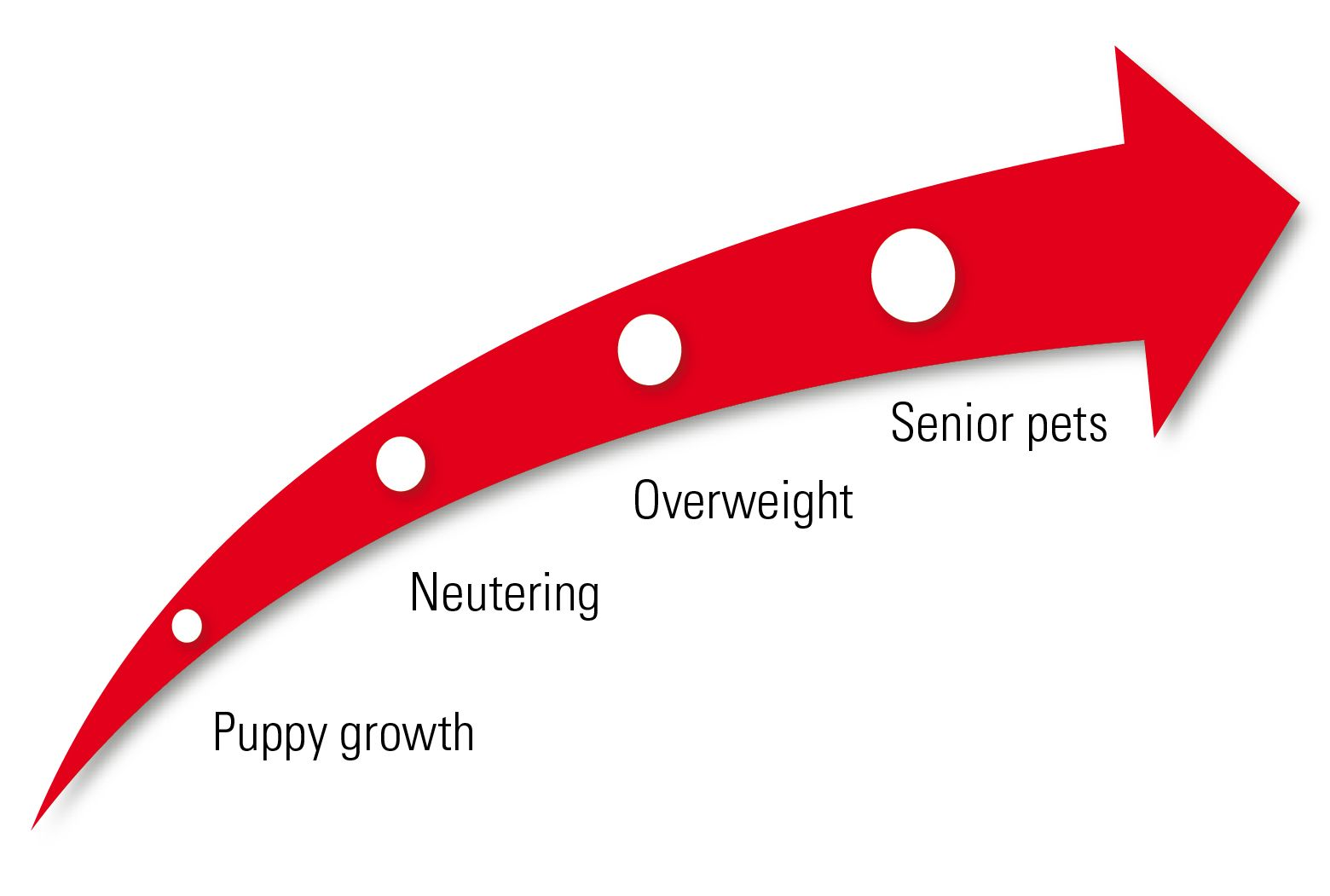Understanding the business (Part 2)
Most veterinarians are not comfortable when discussing fees, or when asked to "sell" something, but this is normal! This chapter offers a method which will allow you to prescribe or recommend products and services effectively.
© Shutterstock

Key Points
Veterinary recommendations, whether for medical treatment, surgical procedures or preventative measures, should only be made when necessary and according to scientifically valid protocols.
Many veterinary surgeons don’t realize that they badly damage their profitability by giving discounts.
Prescribing and selling medicine or foods
As a veterinary physician, your role will be to focus on providing medical and surgical care; this is the very core of your profession. It goes without saying that the economic success of any veterinary practice is based on the quality of services provided and the skill of the team in promoting and recommending these to clients (Figure 2). Nevertheless, as a vet you will always be recommending and hopefully selling drugs, food and accessories. For this reason, in this section we will assess the relative importance of those factors that contribute to successful prescribing and selling.

It is important to note that significant differences exist between countries in the regulations governing the prescription and sale of veterinary services and pharmaceutical products. The provision of veterinary services almost always includes recommendations or prescriptions for items such as drugs, food and sometimes accessories.
However, there are significant variations in how these products can be sold:
- Even within the European Union, national regulations govern whether it is or is not possible to sell recommended or prescribed products.
- Depending on the competitive environment of each country, veterinary practices may or may not be allowed to compete on the open market.
The importance of recommendations
The relevance of distribution
- For owners, the ability to purchase items as soon as they have been recommended is an undeniable advantage, as they get the recommendation and the products in one go, ensuring compliance. This concept is known as “one-stop shopping” and is particularly effective given the convenience it provides for the client.
- As a consequence, the animal is the second beneficiary of the practice distributing products, because compliance improves when recommendations and sales are consecutive. The owner has no need to go elsewhere and there is no risk of them forgetting or changing their mind.
- Finally, for the practice, the sale of products and food provides an additional income stream although this varies according to the competitive environment (see below).
Successful recommendations
A successful recommendation process should include three key elements: It should be clear and unequivocal, it should follow a five-step process and it should be substantiated by a physical document.
A clear and unequivocal recommendation is completely different from one that ends in a list of possible alternatives, leaving the final choice to the owner. The latter method is regularly practised in some countries, often for ethical reasons, as vets strive to remain independent from pharmaceutical companies and petfood manufacturers. It is important to state that veterinary recommendations must be clear and unequivocal. This means they must contain one, and only one, name for a recommended product or food, along with a timeframe for administration. This information is essential to ensure good compliance and, in particular, to guarantee the client has understood. Table 7 on the following page breaks down the prescription process into five stages.
| 1 | |
| The first step is for the vet to define the animal’s needs, allowing the owner to understand that the recommendation is not standardised, but personalised to their animal. For example, “As you have a two-year-old child at home who often plays with your dog and is too young to understand proper hygiene rules, I strongly recommend monthly worming with (your recommended product name)”. | |
| 2 | |
| Next, the vet sets out a response adapted to the animal’s needs; for example, “To validate our hypothesis of a food allergy, I suggest an exclusion diet for a maximum period of 8 weeks during which you only feed your dog a brand that is completely different to its usual brand. If the itching does not stop with this new diet, we can exclude a food allergy. If it does stop, the itching is probably caused by a food allergy and we will then go back to his normal diet to see if it comes back, which will confirm the hypothesis...”. | |
| 3 | |
| The third stage is to formulate the specific recommendation, mentioning the name of the product, the dosage and duration. | |
| 4 | |
| The fourth step is to get informed consent. Following the previous three stages, the owner should fully understand the vet’s technical and scientific plan. The only thing missing is to make them aware of the cost of the proposed solution, which can be expressed as a total figure for a one-off treatment or a regular cost (monthly figures are the best remembered) for preventative measures (such as topical antiparasitic treatments or medical food) or long-term treatments (for chronic illnesses or diet products). Prior to asking for the owner’s consent, it is recommended to give them an opportunity to ask one or more questions, to ensure they have fully understood the situation. | |
| 5 | |
| Finally, it is important to discuss the practical aspects of the recommendation. This includes any possible differences in product or food presentation, practical administration methods and how to monitor the animal (clinical symptoms, weight, etc.). This is also the stage at which reminders should be discussed if necessary. |
Breaking down the prescription process into these five stages may seem pedantic, but in practice it seems that many vets skip the first and last steps. Highlighting the animal’s needs is an absolutely essential step to ensure the owner understands that the prescription is adapted to their pet’s particular circumstances. Explaining any potential practical issues helps to ensure greater compliance and can be complemented by a demonstration where necessary. In addition, while the concept of informed consent is included in all professional ethical codes, it can be difficult for vets to ask the key question, “Do you agree to this treatment or new food?”. You should never forget that a recommendation is only a proposal and that it is the owner who has the final say; even if there is no technically valid alternative. Therefore, they must give their explicit consent.
Creating the prescription
Recommendations should always be provided in writing (Figure 3), particularly if there is a statutory requirement to issue a prescription. The prescription and/or supporting document fulfils three functions:
- Legal: when a prescription is required.
- Communication: the prescription or supporting document sets out the main points mentioned by the vet during their discussion. This not only helps the owner remember the vet’s recommendations but can also help them pass key information on to other people who were absent during the discussion but who may be involved in or will influence the decision-making process.
- Educating: helping the owner follow the recommended treatment, for example, a treatment calendar for internal or topical administration of antiparasitic products during the year, a dietary transition schedule, a ration plan or a diagram explaining how to apply ear solution.

These documents take time for often overworked vets to prepare. Therefore, it is important to design the recommendation process to be a team effort and to see what can be delegated. Although seeing a vet is essential for the first stages of the process, it is generally better to delegate the final stage (practical issues and reminders) to the support team, assuming there is one and it has the time. Occasionally, it might also be possible to delegate part of the first stage as well, particularly gathering information relating to the animal’s needs (e.g., a lifestyle questionnaire for preventative treatment).
Additionally, the recommendation process is complex, and understanding it requires training, practice and experience. Many vets are not initially comfortable with all the stages, particularly addressing pricing or gathering informed consent, although it is rare for them not to improve once they have received training and developed the process within their teams.
How to sell products well
The main sales driver for medication and food in a veterinary practice is a recommendation from the vet. Without this recommendation, results are mostly disappointing.
The first essential step to understanding the competition is to identify local as well as international competitors. The situation will vary from country to country and from product to product in relation to local regulations and market contexts. Generally, there is more competition for less regulated products such as food or over-the-counter medication. This is particularly the case for large, well-known brands, and especially for bulk packaging with a higher face value. Depending on the country, local competition will primarily include pharmacies, garden centres or pet shops and occasionally large supermarkets (although these mainly sell products that are very different to those found in veterinary surgeries). In almost all countries, global competitors are now Internet-based marketplaces that distribute lifestyle and prescription foods and often over-the-counter or prescription drugs. In order to understand these competitors, vets must be aware of their performance in terms of convenience (location, opening times, delivery) and especially price.
The second essential step is to implement a pricing strategy designed to ensure the veterinary practice remains competitive within its environment. Based on an awareness of the prices offered by its competitors for products recommended by their vets, practice owners can set their own prices using a “not more expensive than elsewhere” strategy. This means that prices closely match, but are still a little more expensive, than those found elsewhere. This difference is usually very small and not quite proportional (so it cannot be expressed as a percentage). In particularly competitive markets, it has been empirically noted that a difference of around, for example, 3 euros is acceptable for prices between 20 and 25 euros. This means that the price of a product in an extremely competitive market (namely food, over-the-counter medication and increasingly prescription drugs for long-term treatments) can no longer be set by adding a standard mark-up to the purchase price, but that it depends instead on an analysis of the competition.
Subsequently, a third stage is required. This involves setting up a reliable purchasing structure that allows the practice to achieve the best net price from its suppliers, whether these are pharmaceutical laboratories, petfood manufacturers or specialised wholesalers. Although the situation can vary from country to country, in some parts of the world, vets have managed to create very competitive purchasing structures by grouping together.
Is it profitable?

In order to sell effectively, vets need to ensure that:
- Their practice is well situated, visible, with ample parking spaces and a reception area that is spacious, light and where products can be displayed attractively with minimum storage requirements (even if supplier logistics are often able to provide frequent, low-cost deliveries to the surgery).
- They have staff available in the reception area with extended opening hours for convenient client access.
- They have stock, which requires working capital.
- They manage this income stream by monitoring the competition, setting sale prices, negotiating purchasing, etc., which takes time.
The total cost is therefore significant, and it is easy to understand why it deters many vets. Nevertheless, we can appreciate that a well-situated, visible surgery with ample parking spaces and a large, well-lit reception area, extended opening hours and reception staff are all prerequisites to ensure a good medical and surgical service. The only additional costs are a storage area, the stock itself, managing the income stream and, perhaps, some additional staff and space in the reception area. With this approach, it is possible to suggest that the additional income provided by drug and food sales can contribute towards the significant income needed to ensure high levels of veterinary care.
Additionally, by far the main cost involved is the time dedicated to recommending products to clients. However, as noted previously, recommending products or treatments is an essential part of veterinary practice whether these same items are being sold on site or not. Given this fact, why not sell the products if it is possible to do so?
Another argument that is often put forward is whether it is better to concentrate on enhancing or providing additional services, and leave product sales to the more aggressive competitors? Of course, developing services quantitatively and qualitatively, enhancing them and innovating by offering new services are important priorities when growing a veterinary practice. So, the real question is how does developing product sales hinder a practice’s ability to develop, improve or innovate its services?
- In hospitals and specialised veterinary surgeries that work only with referred patients, product sales are often only a minor issue.
- In small general veterinary practices, with little space and few support staff, it may be more practical to focus on a service-based business model. However, it might also be worth considering the medium-term sustainability of these models.
- In medium and large general veterinary practices, with enough reception space and a small storage area, a business model that combines high-quality, enhanced services with high-quality products sold at competitive prices can be economically efficient as there is a strong relationship between these two activities. Economic performance can be further enhanced by managing the supply costs, through the rationalisation of purchasing and the optimised management of competition and sales prices. This is often achieved by several practices grouping together.
Is it ethical?
The most extreme criticism of veterinary practices that sell drugs and food is often based on ethical arguments. Is it not a conflict of interest for vets to prescribe and dispense at the same time? If vets prescribe products and then sell them, will they not run the risk of being, or appearing to be, in the pay of the drug and food manufacturers? As with human medicine, these questions are often asked by policy makers, professional bodies and some consumer associations.
However, as long as some simple rules are followed it seems unwarranted to claim that all product sales violate the professional ethical code:
- Recommendations (for treatments as well as preventative measures, hygiene products and food) should only be made when necessary and according to scientifically valid protocols. The indications and protocols should be discussed and approved by the whole practice team, based on consensus recommendations issued by the various international expert groups (such as ESCCAP 1 for parasitology or ABCD 2 for feline infectious diseases). For example, Figure 5 shows four targeted moments when preventative food should be prescribed.
- Products should be selected by the practice for recommendation and supply only if they are well known and meet the needs of animals treated by the practice.
- The range of products on offer should be limited and focused on key products. Veterinary surgeries are recommendation networks, so they should offer a limited choice. This is in contrast to garden centres, pet shops or Internet sites which do not provide recommendations. To maintain this distinction, veterinary surgeries should avoid the temptation to turn themselves into a general pet shop or create a pet shop space within the surgery.
- The prices for products offered should be comparable to those of other suppliers because price competitiveness is a key aspect to providing an ethical service.
1 European Scientific Committee on Companion Animal Parasites
2 Advisory Board on Cat Diseases

Discounts and waived charges: a toxic plague for our profession
Many owners of veterinary centres acknowledge that discounts on the price of the services provided are given to clients far too often. For example, many clinics omit to charge for rechecks or short consultations. In many hospitals, considerable oversights or omissions arise when charging for the services provided to hospitalised patients such as neglecting to charge for foods and medications administered.
For businesses with low profitability margins such as veterinary practices, discounts and fee cancellations may have a serious impact on their financial viability.
Some studies have shown that up to 6% of a clinic’s annual revenue may be lost in the form of discounts. In other words, between a third and half of the clinic’s anticipated annual profits, equivalent to the owner working for between four and six months for free!
In most cases, this “discount culture” has not been created by the centre’s young veterinary surgeons, it is a tradition established by the owner(s) of the practice, who as a consequence lose all legitimacy when they ask their young employees to behave differently from themselves.
- They encourage a toxic behaviour, financially speaking, that will probably accompany them for the rest of their career.
- They educate the client to expect a discount associated with each future service, creating confusion and dissatisfaction when this does not occur (“Why wouldn’t the doctor give me a discount today? Is he angry with me?”).
- Discounts are the best alibis for a mediocre service (Figure 6). When we expect to charge the full amount for all of our services, we automatically raise the bar for the standard of service we expect to provide because we remove the convenient “shortcut” of resorting to a discount when something doesn’t go perfectly. Worse than that, we can try to get away with suboptimal results knowing beforehand that we can smooth it over with the discount…
- They considerably damage productivity and therefore impact our salaries. The veterinary surgeons that habitually give discounts generate less income and, therefore, make themselves a hostage to lower salaries.
- Clients don’t love or respect us more for giving them discounts. Clients love and respect us when we are competent and when we show respect, kindness and empathy towards them.

Conclusion
The world is full of veterinary surgeons who are very good at providing professional animal healthcare, but who are very poor at managing their clinic’s finances. However, good animal care can only be provided by ensuring a profitable and sustainable veterinary business. Understanding the basics behind what makes a practice profitable, and knowing – and correcting – the key factors that can contribute to poor financial performance, are skills that will make a recent graduate hugely valued.Philippe Baralon
DVM, MBA
France
Dr. Baralon graduated from the École Nationale Vétérinaire of Toulouse, France in 1984 and went on to study Economics (Master of Economics, Toulouse, 1985) and Business Administration (MBA, HEC-Paris 1990). He founded his own consulting group, Phylum, in 1990 and remains one of its partners to this day, acting primarily as a management consultant for veterinary practices in 30 countries worldwide. His main areas of specialization are strategy, marketing and finance, and he is also involved in training veterinarians and support staff in the field of practice management through lectures and workshop, as well as benchmarking the economics of veterinary medicine in different parts of the world. A prolific author, he has authored more than 50 articles on veterinary practice management.
Antje Blattner
DVMGermany
Dr. Blaettner grew up in South Africa and Germany and graduated in 1988 after studying Veterinary Medicine in Berlin and Munich. She started and ran her own small animal practice before undertaking postgraduate training and coaching course at the University of Linz, Austria and then founded “Vetkom”. The company provides training to veterinarians and veterinary nurses in practice management in subjects such as customer communication, marketing and other management topics. Dr. Blaettner also is editor for two professional journals, “Teamkonkret” (for veterinary nurses) and “Veterinärspiegel” (for veterinarians).
Pere Mercader
DVM, MBASpain
Dr. Mercader established himself as a practice management consultant to veterinary clinics in 2001 and since then has developed this role in Spain, Portugal and some Latin-American countries. His main accomplishments include authoring profitability and pricing research studies involving Spanish veterinary clinics, lecturing on practice management in more than 30 countries, and authoring the textbook “Management Solutions for Veterinary Practices” which is published in Spanish, English and Chinese and has sold worldwide. In 2008, he co-founded VMS (Veterinary Management Studies), a business intelligence firm that provides a benchmarking service for more than 800 Spanish veterinary practices. Dr. Mercader was also a co-founder of the Spanish Veterinary Practice Management Association (AGESVET) and served on its board for eight years.
Mark Moran
MBAUnited Kingdom
Mark Moran has been a consultant to the veterinary profession for the last 19 years, providing business mentoring and support for veterinary clinic owners and key staff. His work involves helping veterinary practices create effective working environments, with happy staff, that meet the business owner’s values and expectations. He has a special interest in helping practices to improve their patient’s compliance to veterinary recommendations by making better use of data systems.
Other articles in this issue
Share on social media